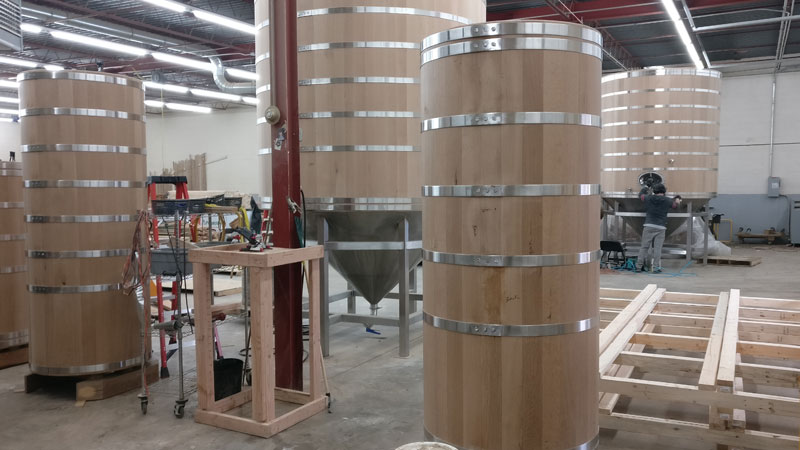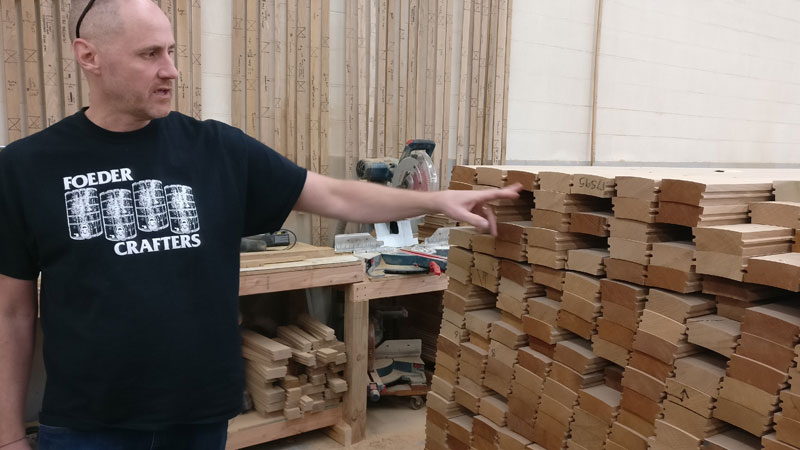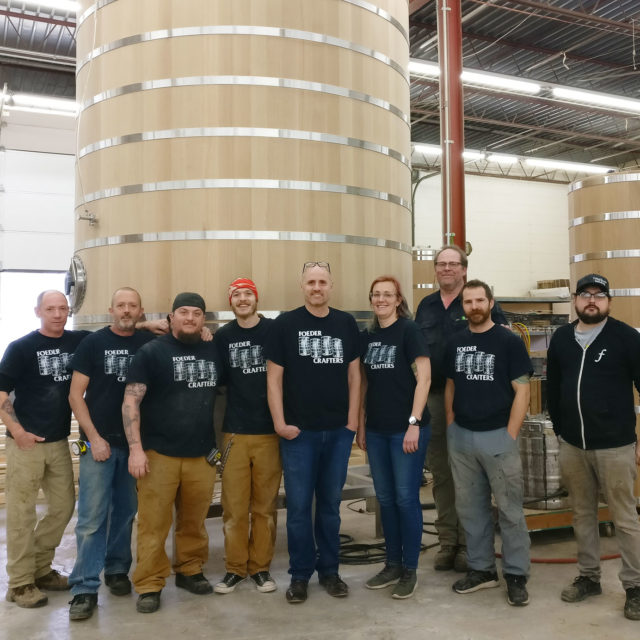“We’re getting a stick rack today. This has been a four-year fantasy,” Matt Walters, co-founder and owner of Foeder Crafters of America (FCA), says.
Based in an industrial park in a St. Louis suburb, FCA is the only company in the United States manufacturing foeders. These enormous oak barrels are traditionally winemakers’ tools, but they’re also used by Belgian breweries like Brouwerij Boon and Rodenbach to produce funky and tart lambics and gueuzes.
Historically, if you wanted wild beers, you looked to Belgium. In the last decade, however, many American brewers started exploring the benefits of brewing with wild yeast and other microflora in foeders. It’s a complicated, expensive way to brew, but that hasn’t stunted the category. American wild ale is quickly transforming from ultra niche to bona fide crossover star.
Since launching FCA in 2014 with co-founder Justin Saffell (who he later bought out), Walters has been lowering the barriers to entry for American brewers interested in wild ales. Business is booming. (“We’ve been over-subscribed since we started,” Walters says, “Sales is not our problem.”) Their challenge now is keeping up with demand and maintaining quality, as the American craft beer market continues evolving at warp speed.

The “stick rack” looks exactly like it sounds, an assortment of wooden staves of varying lengths, each marked with arrows and lines. These indicate where bands and fittings should go, so each piece of wood is like an assembly manual for a particular type of foeder. “If you give one of these guys the stick, they know right away how to make the foeder. It answers every question,” Walters says.
Brewing wild and sour beers is expensive. Barrels are pricey, and loss is part of the (long) process.
“It’s part of the game with our beer, there’s always a little bit of loss,” says Cory King, owner of Side Project Brewing, a Maplewood, Mo.-based brewery that specializes in barrel-aged beer. King estimates that Side Project loses around 20 percent of its output annually due to evaporation or the beer going bad.
As with anything that entails aging, long production cycles slow profits.“We put beer in barrels for six months to a year, to two years, or three years,” King says. “Those are just sitting on a floor that I’m paying rent on. You’re not producing anything, they’re just there.”
King was one of FCA’s earliest customers. He notes how dramatically the market for American wild ales has changed in the last decade. Even in 2010 or 2011, the availability of sour beer in Missouri was limited to “special releases for breweries outside the Midwest. You couldn’t walk into a bar just to have a good sour beer and enjoy yourself,” King says.
Across the country, however, select brewers were already producing tart, wild beers. Jolly Pumpkin in Michigan, New Belgium in Colorado, Russian River in California, and Allagash in Maine were among those ahead of the curve.
Jeff Stuffings co-founded Jester King Brewery in 2010 in Texas Hill Country near Austin, where he brewed farmhouse ales and other wild styles. Stuffings was surprised by how quickly business took off. “I thought that it was going to take some time, or that it might not even work at all in Texas,” he says. “But I think the market had been primed, at least among beer nerds, by the hype that was starting to build.”
Jester King and Side Project, which King opened in 2013, were part of a wave of new breweries focusing exclusively on wild and sour beers. “As we were popping up you have de Garde out in Oregon making exclusively funky sour beer, everything touching oak,” King says. “The Rare Barrel out in California were doing the same thing, and Sante Adairius heavily focused on their farmhouse, oak-aged sour beers as well.”
King initially sourced oak barrels, mainly from Missouri wineries, for his brewery, but supply was limited. He came across a mention of Foeder Crafters of America – “I think via social media,” he says – and after discovering it was based in the St. Louis area, he decided to pay Walters and Saffell a visit.
He put a deposit down on his first FCA foeder almost immediately, and it remains in use at Side Project. “It’s our best-producing foeder, because it’s our most mature, with the most mature cultures. It’s a great thing,” he says.
The Missouri oak used in each FCA foeder is dried for two years before it’s brought to the workshop. From there, the construction process takes a couple of days. “We don’t bend or steam any wood,” Walters says. “I believe that once you bend wood, the wood wants to go back to where it was. So we machine the curves on both sides. We have to make a different stave for every radius that we have.”
Foeder makers at FCA assemble each barrel by hand. The foeders then spend a week being finished, which involves filling them with water and steaming.
FCA now has a staff of almost 10 in its workshop, and offers highly customized foeders in around 60 different combinations of shapes and sizes. They can be made to sit vertically or horizontally, and can be cylindrical, oval- or egg-shaped. Capacity runs from a 21-gallon foeder for homebrewers up to 250 barrels.
“The ability to customize your foeder is huge,” King says. “They make it to fit where it needs to go, and they put valves and cooling plates in, or racking arms or whatever they need to do.” If taken care of, the foeders can last over 100 years.
Foeder Crafters currently ships 25 to 35 foeders every month, up from its 2018 average of 19.5 per month. Walters estimates that repeat business accounts for around a third of sales.
FCA’s clients span some 400 breweries across the United States, including Great Raft Brewing in Louisiana, Washington’s Wander Brewing, and Flying Dog Brewing of Maryland. It also provides foeders for brewers in Canada, Australia, Brazil, Japan, Hong Kong, and Taiwan.
Accessibility and price are key to FCA’s success. Walters says that, typically, a 30-barrel French foeder would cost about $18,000 to import to the U.S., including around $5,000 in shipping costs. Comparable equipment from FCA would come in at around $12,000, depending on specifications.
“Imported foeders have gone way down since we published our pricing,” Walters says, noting that the prices of French foeders nearly halved. “But we don’t do much wine stuff, and they don’t do much beer stuff, so we’re kind of leaving each other alone.”

Not every foeder is used to produce wild and sour beers. Many FCA clients use their foeders to brew clean lagers, Walters says.
While there are more acidic and funky beers on the market than ever before in America, Stuffings says the sour hype has plateaued.
“I think in 2019, the market has shifted away a little from having wild fermentation and Lambic-inspired beers as one of the most popular things. That’s not entirely a bad thing,” he says. “It will remain a niche, but you’ll get converts. We get plenty of wine drinkers who love wild ales and sour beers from the first taste because of the natural overlap, especially with natural wines.”
Creatively, wild beer is still in its infancy, King says, and emphasizing terroir-driven beers gives brewers and the category itself considerable growth potential.
“I think that it’s still the focus on the sense of place, using local micro-flora,” he says. “It’s something we’ve done since day one, but really, on two hands I could name all the breweries at that time doing it. Fortunately, now there are more … It’s a natural progression. If wine has done it, there’s no reason beer won’t be doing it, just 100 or 200 years later.”
To secure their legacy and longevity, some brewers are working together to establish best practices and ensure category quality. King and Stuffings were both instrumental in establishing the Sour and Wild Ale Guild (SWAG, amusingly). Stuffings says that SWAG was formed to promote wild and sour beer to the customer, but also to improve quality in the category.
“These are beers that have a bit of a higher price point, and if the quality’s not there it can turn people off quickly,” he says. “They’re not easy beers to make, they require a lot of patience and discipline, and a pretty good palate as well.”
They’re also easy to misrepresent. For example, kettle souring is a quick and inexpensive technique for creating sour beers, but it’s unregulated. As a result, unscrupulous or simply uninformed brewers could easily misleadingly market their kettle-soured beer to consumers. “People can make a kettle sour in a matter of four days, put it in a barrel for one day, and then they could put it on the shelf and say, ‘This is our wine barrel-aged wild ale,’” says King.
Establishing agreed terminology for describing various types of wild beers is another priority. “You probably noticed I shied away from calling them ‘sour’ beers,” Stuffings says. “I think of a chef, who would never say ‘I’m going to make the most sour dish I can make’ – it’s about creating acid that balances and makes the beer more inviting.”
King is optimistic about the guild’s prospects. “We were hoping this could start the direction of the education of the consumer, or it could be self-regulating for members of SWAG,” he says. “You don’t want to be a member and then lie to everybody. So maybe members of SWAG get to put the SWAG logo on the bottle. So you know what you’re buying, and they’re actually being honest with you.”
For Matt Walters, Foeder Crafters of America’s battle is ensuring its supply of wood matches the growing demand for foeders. “That’s our daily struggle,” he says. “We’ve been over-subscribed since we started.”
It all starts with the oak, Walters says, and the climate that oak grows in. “It had to be here. Missouri’s oak is by far the best,” he says. “A lot of people tried it on the East Coast, but the oak on the East Coast is terrible. Oak from Wisconsin? Their summers are too easy. Down south? Their winters are too easy. This is the sweet spot.”
